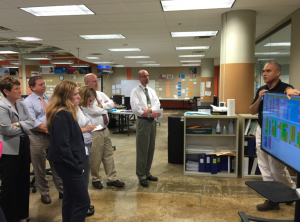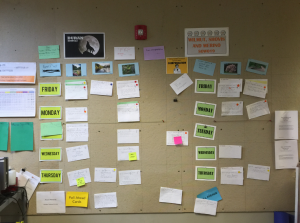Say that title fast! We held our quarterly IT leadership retreat this week. As we continue on our lean journey, I decided a field trip was in order.

James Goebel explains how employee can see their scheduled tasks on the resource management digital board at Menlo Innovations.
We spent two hours at Menlo Innovations getting a private group tour from co-founder James Goebel. To prepare, we read the “The Joy of Lean Innovation: A Case Study of Menlo Innovations” and listened to a Gemba Academy podcast of an interview with Richard Sheridan, Menlo Innovation’s founder and CEO. Many others from University of Michigan Health System have visited Ann Arbor based Menlo over the years. I’d been encouraged to make a visit by my lean coach, Margie Hagene, and our internal UMHS lean champion, Dr. Jack Billi.
Menlo is a software design and development company. But we weren’t visiting to understand their approach to software. Rather, we wanted to understand how they have applied lean principles to run their business and create the culture that Richard Sheridan describes in his book, “Joy, Inc. – How We Built a Workplace People Love.”
Two of our new IT directors are in their third week, so we started the retreat by each describing the most effective leadership team experience we’ve had. The themes that emerged:
- common mission, vision and goals
- passion
- focus
- proximity to each other
- trust
- ability to deal with crisis
Amazing how well this exchange flowed right into the Menlo tour which was next on the agenda.
What did we hope to learn at Menlo? A few things on our list were:
- how they used visual management
- how their paired staff approach worked
- how open workspace works for them
- how they sustain their joyful culture
So what did we see and hear?
James Goebel described their core approach and business philosophy for 30 minutes. Then he walked us around the workspace. We watched their daily huddle that ranges from 50-100 people depending on the current client work – each pair of staff describes their work for the day and what other pairs should expect from them. This huddle is over in 15 minutes or less.
Next we saw their resource management digital board. It shows each person’s project assignment for every ½ day of the current week. It’s a simple and clear visual of who is working on which client project and when. It was the only digital display we saw – everything else was paper on just about every square inch of wall. There was corkboard everywhere.

This visual management system, the work authorization board, tracks the various work streams for each project across the course of a week. Employees can tell what others on the same project are doing and can easily see where help might be needed.
Then we went to their work authorization board that shows the current activity for each project. It is updated by team members throughout the day as tasks are completed and next tasks are started. He explained in detail the process of estimating project work.
We saw that their workspace is configured by project – each project team has a “pod” that they all work around – a set of easily movable tables with computers. The space is configurable as project teams grow or contract and new ones are added.
We then had our own post-tour discussion filling a conference room wall with flipchart notes. Some of our key themes:
- cross training to address what Goebel called the “tower of knowledge”
- prioritizing and making tradeoffs to accommodate new work vs. just adding on more
- workspace
- email vs. talking
So what to do with all we learned?
Given our current improvement efforts, we can only take on so much at a time. At our next leadership meeting in two weeks, we will learn from some of the current processes and experiments in parts of our own department. There are experiments with team based huddles, prioritization of work for certain customer groups, and resource management. I expect that all of us will be inspired by Menlo Innovations to experiment with simple changes.
How about behavioral changes? We all want to be using email less and talking more. Yes, we’re spread across locations but most individual teams are in the same work area. And the teams that work closely together are often near each other. I’m certain we can and should just go find each other, or pick up the phone, more often than we do.
I will propose a couple visual management experiments for our leadership team and my support staff that I have been thinking about since visiting the Lean Enterprise Institute a few weeks ago. And of course, I will process all this with my lean coach when we talk – she is great at pushing me to experiment.
Resources:

Richard Sheridan on said:
Sue, I’m so glad you and your leadership team got a chance to visit Menlo and meet James. I look forward to hearing more stories about your journey and the progress you are making.
Sue Schade on said:
Rich, thanks again for letting us learn from you like so many others have over the years!
Jack Billi on said:
Great description of visual controls applied to information system work. I’m impressed that Sue brought her leadership team, so they can “see together, understand together, and act together”. Shared experiences lead to teams developing shared vision of what they can create together.
Sue Schade on said:
Jack, thanks for all your support and encouragement. We are definitely making progress!
Sherry Mason on said:
Sue, what a great opportunity to stimulate creativity and a culture of continuous improvement among teams. Your weekly posts continue to provide the impetus for me to remain focused and passionate about my work, while being cognizant of the importance of engagement, accountability and Lean learning. Perhaps next steps for managers would be to discuss these experiences with team members to keep the momentum going.
Sue Schade on said:
Sherry, thanks for the note. Hoping directors will share some of the learnings with managers and staff. Watch for more communications as we continue on this lean journey.